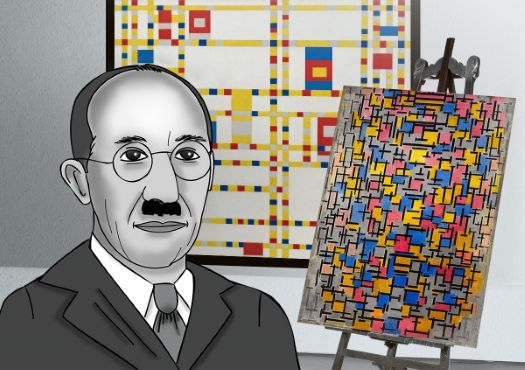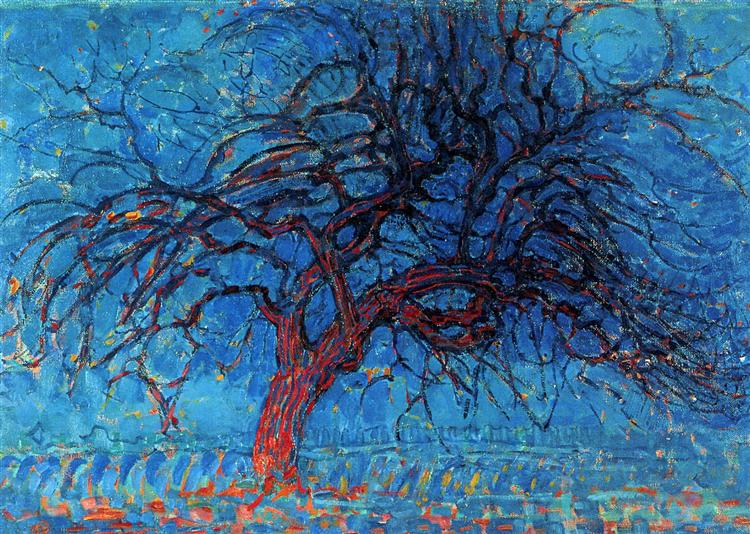Week 2: Math + Art
Prior to this week's lesson, I had never taken into consideration the connection between math and art. And, quite frankly, I didn't even realize there was such a connection! I suppose this can be attributed to the extremely narrow view of mathematics that I previously held. For me, math simply meant the study of numbers. However, after viewing Professor Vesna's lecture, I soon came to realize that math is so much more! Not only is it the science of numbers and the relation between them, but it is also the study of the relationship of combinations, abstractions, shapes, forms, measurements, spaces, and so on (Vesna). Based on this, we can say that both artists and mathematicians find much common ground in using principles of geometry within their work (e.g., proportion, measurement, angles, symmetry, etc.). It is this commonality that has ultimately allowed for mathematics to have an incredibly profound influence on the discipline of art.
 |
| "Piet Mondrian." The Artstory, https://www.thehistoryofart.org/piet-mondrian/. |
An artist that particularly caught my attention in this week's lecture was Dutch painter and theoretician, Piet Mondrian. Mondrian is best known for his unique geometric abstract artworks, consisting of squares and rectangles, as well as primary colors (red, yellow, and blue). Surprisingly, Mondrian began his art career as a traditional painter whose work was mainly naturalistic and impressionistic in style. In fact, he initially took chief interest in painting trees, as he was fascinated by their structure and the geometric patterns of their branches.
 |
| "(Avond) Evening: The Red Tree." WikiArt, https://www.wikiart.org/en/piet-mondrian/avond-evening-the-red-tree-1910. |
Beginning in around 1920, Mondrian made the transition to completely abstract paintings, as shown below. As briefly touched upon by Professor Vesna, Mondrian believed that simple geometric shapes could be used to "express reality, nature, and logic from a different point of view" (Lecture). According to Mondrian, it was the asymmetrical arrangements of geometric figures, rather than organic ones, that best represented what he called the "universal forces" of the world. Ultimately, his ideas led to the emergence of the Neoplasticism ("new art") movement, which places emphasis on the basic elements of line, form, and color. Overall, then, we can say that Mondrian's work is a prime example of the ways in which mathematical concepts can serve as a source of creative expression in one's given art form.
 |
| "Composition A." Art in Context, https://artincontext.org/piet-mondrian/. |
Works Cited:
1.) Henderson, Linda D. "The Fourth Dimension and Non-Euclidian Geometry in Modern Art:
Conclusion." Leonardo, Vol. 17, No. 3, 1984, Pp. 205-210.
2.) Kris, Deborah. "Picture This: Using Art to Explore Math (and Math to Create Art)." PBS,
https://www.pbs.org/parents/thrive/picture-this-using-art-to-explore-math-and-math-to-create-art.
Accessed April 13, 2023.
3.) Meleca, Amy. "Neo-Plasticism Art Movement." Artlex, https://www.artlex.com/art-movements/neo-
plasticism/. Accessed April 13, 2023.
4.) "Mondrian, Composition with Red, Blue, and Yellow." Khan Academy,
https://www.khanacademy.org/humanities/ap-art-history/later-europe-and-americas/modernity-
ap/a/mondrian-composition. Accessed April 14, 2023.
5.) "Piet Mondrian: The Life and Works of the Color Block Artist." Art in Context,
https://artincontext.org/piet-mondrian/. Accessed April 13, 2023.
6.) "Piet Mondrian and His Paintings." Piet Mondrian.org, https://www.piet-mondrian.org. Accessed April
14, 2023.
7.) "Piet Mondrian: Artist Biography with Portfolio of Paintings, Drawings, and Prints." The History of
Art, https://www.thehistoryofart.org/piet-mondrian/. Accessed April 13, 2023.
8.) "The Mathematics in Art." The Art of Maths, https://artofmaths.eu/the-mathematics-in-art/. Accessed
April 13, 2023.
9.) Vesna, Victoria. Lecture: Mathematics. DESMA 9: Art, Science, and Technology. University of
California, Los Angeles.
10.) "Why did Piet Mondrian Paint Trees?" The Collector, https://www.thecollector.com/why-did-piet-
mondrian-paint-trees/. Accessed April 14, 2023.

Hi Jenna!
ReplyDeleteI also found it fascinating to learn about the connection between mathematics and art, such as the principles of geometry in many artistic works. From your blog post about Math and Art, it can be understood that the transition that Mondrian made in his painting style further emphasizes the versatility and applicability of mathematical concepts in abstract art. To my surprise, there are many artists who rely on geometry principles to create their artwork and challenge traditional representational art. I particularly enjoyed learning about this week's material as we got to gain a better understanding of both disciplines, as well as the intersection between math and art.
Thank you for sharing your insights on this topic in this week's blog!
Rachel Trinh